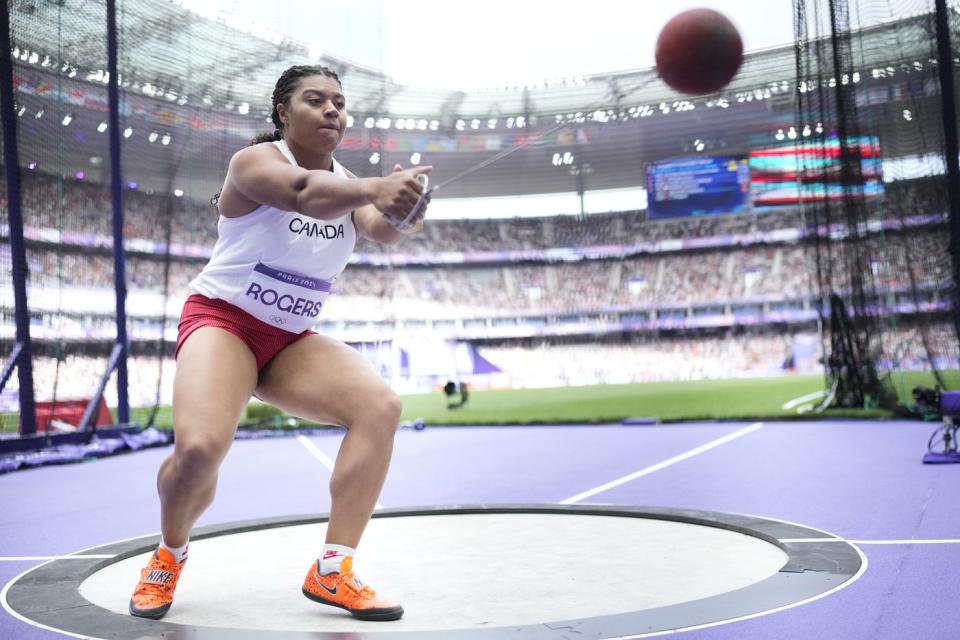As Canada rules hammer throw in Paris, interest is soaring — especially among girls

More girls are lining up to learn hammer throw in Canada, awed by the grace and power of Camryn Rogers and other athletes who hurl weights through the air like some kind of intergalactic beings launching planets through space.
The sport is still gaining traction across the country, and Canada's recent dominance at the Paris Olympics — in both the men's and women's categories — is the culmination of decades of hard work, said Larry Steinke, coach of Jillian Weir, who finished 19th in the 2020 Tokyo Games and third in the 2022 Commonwealth Games.
But Steinke said he hopes this week's Olympic gold medals for Rogers and Ethan Katzberg will accelerate the momentum and attract more young throwers to the sport.
"It's one of those events that if people are introduced to it, they find it fascinating, and it's addicting right from the beginning … just seeing the hammer fly further all the time," Steinke said in an interview Thursday. "It would be fabulous if we were able to have (hammer throw) across the country."
Hammer throw is all about power, strength, balance and athleticism, and it's no surprise to Kristen Dajia, vice-president of the Throwers Club in North York, Ont., that there are more young people — particularly girls — signing up for hammer throw in the club's meets each year.
"We suddenly have, like, 14 girls in the hammer throw competition," Dajia said in an interview Thursday. "You used to have one or two. There is such a resurgence of hammer throw."
Hammer throw is one of four throwing events in track and field. Athletes aren't actually throwing hammers, they're launching metal balls weighing four kilograms in the women's competition and more than seven kilograms in the men's. The balls are attached to long steel cables, which they grip with a handle.
The athlete swings the apparatus around their head a few times to build momentum and then lowers the handle to chest height and spins, with the ball orbiting around them. They turn as quickly as possible with their arms extended, creating centripetal force. At just the right moment, they let go, sending the ball hurtling through the air. Whoever throws the farthest wins.
Katzberg won the gold in Paris on Sunday with an 84.12-metre throw. Rogers won the women's match on Tuesday, throwing nearly 77 metres.
Hammer throw is a gob-smacking spectacle — a "celebration of power," Dajia said. The 61-year-old was among the first women to throw hammer competitively in Canada, and she is now a top master thrower and holds the record for 60-year-old Canadian women.
"I cried when (Camryn Rogers) won," Dajia said. "It was so hard for us back in the 1980s. We knew we had to work really, really hard and have really, really good technique in order to be taken seriously, in order to even get our event into a national championship."
The young girls getting in touch with Dajia's club are inspired by Weir, Rogers and Katzberg.
The Legion National Youth Track and Field Championships begin Friday in Calgary, and Steinke said there are more girls signed up for hammer throw than he's ever seen.
Good throwers — even Olympic-level throwers — come in all heights, said Steinke, noting that while Katzberg is six-feet-seven-inches tall, Rogers is more than a foot shorter.
"There's an opportunity for someone who is shorter, but can be fast, powerful, explosive … there's an opportunity for almost every size and shape," he said.
Dajia noted that hammer throwing is also easy on the joints and excellent for building strength and balance, so people of all ages can get good at it.
Most people get into throwing through track and field, but those who play rugby, football, hockey and basketball make fine throwers too, Steinke said. However, there are still few opportunities for young people to try it out: only British Columbia offers hammer throwing as part of its track and field events in high school, despite ongoing efforts by Steinke and others to encourage other provinces to include it.
"There's just a very big reluctance," he said. Proper facilities need a "fairly significant" cage system to catch errant throws, and that's expensive. Officials also worry about hosting events where students are hurling metal balls into the air amid hundreds of their peers, Steinke said.
Canadian winters are a challenge, too. Steinke is the head coach at the University of Lethbridge in Alberta, where there is an indoor facility for the sport. Before that, he said, he and his athletes would string up huge nets in an old concrete stairwell and practice there during the winter.
Dajia said she used to shovel off a spot to spin and throw into the snow.
There is a hammer cage at the Toronto Track and Field Centre, but it closed in early June for repairs, she said. She and the girls who've signed up for meets have to drive to facilities in Niagara or Brampton to compete, Dajia said.
Young people hoping to get into hammer throw but who don't have access through their school can look for local track and field clubs, or throwing clubs like hers, she suggested.
She, too, hopes this week's Olympic hammer throwing fervour will inspire more athletics organizations and, in her case, City of Toronto officials to recognize that Canada is now a world leader in hammer throw and it's worth investing in the sport.
"It just changed my life so much, and I want everyone to have that opportunity," Dajia said.
This report by The Canadian Press was first published Aug. 9, 2024.
Sarah Smellie, The Canadian Press

 Yahoo Sports
Yahoo Sports 
